Leadership, Management, and Operational Approaches at Marks & Spencer
VerifiedAdded on 2020/06/04
|13
|3885
|48
Report
AI Summary
This report provides an in-depth analysis of leadership and management practices within Marks & Spencer (M&S), a multinational retailer. It differentiates between the roles of leaders and managers, outlining their respective functions and characteristics within the organization. The report explores various leadership theories, including situational, contingency, and systematic leadership, evaluating their applicability within M&S. Furthermore, it delves into operational management approaches, such as the dynamic approach, and examines their significance in enhancing efficiency and productivity. The report highlights the importance of operational management in the context of a competitive retail environment and discusses factors impacting operational management, providing a comprehensive overview of leadership, management, and operational strategies employed by M&S to achieve its business objectives.
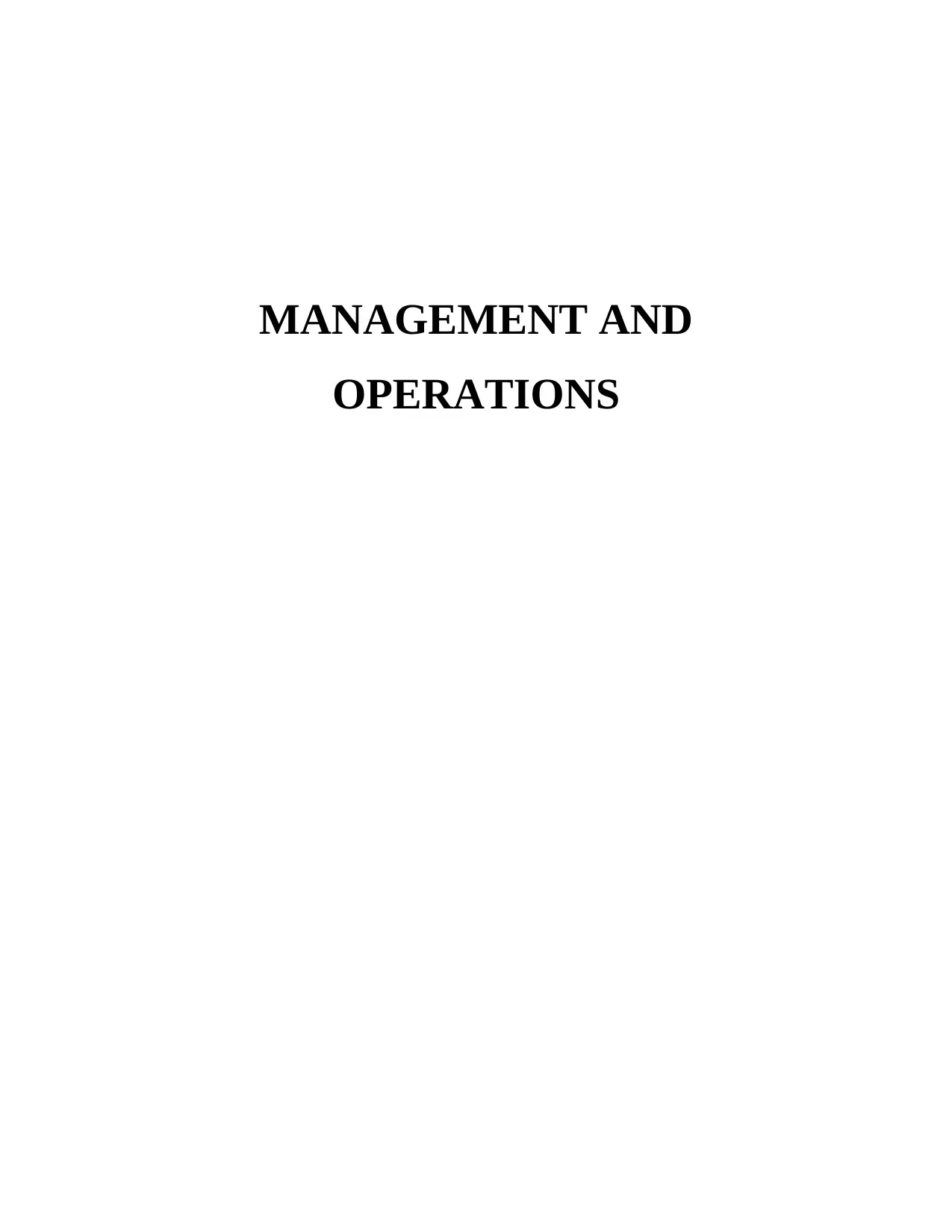
MANAGEMENT AND
OPERATIONS
OPERATIONS
Paraphrase This Document
Need a fresh take? Get an instant paraphrase of this document with our AI Paraphraser
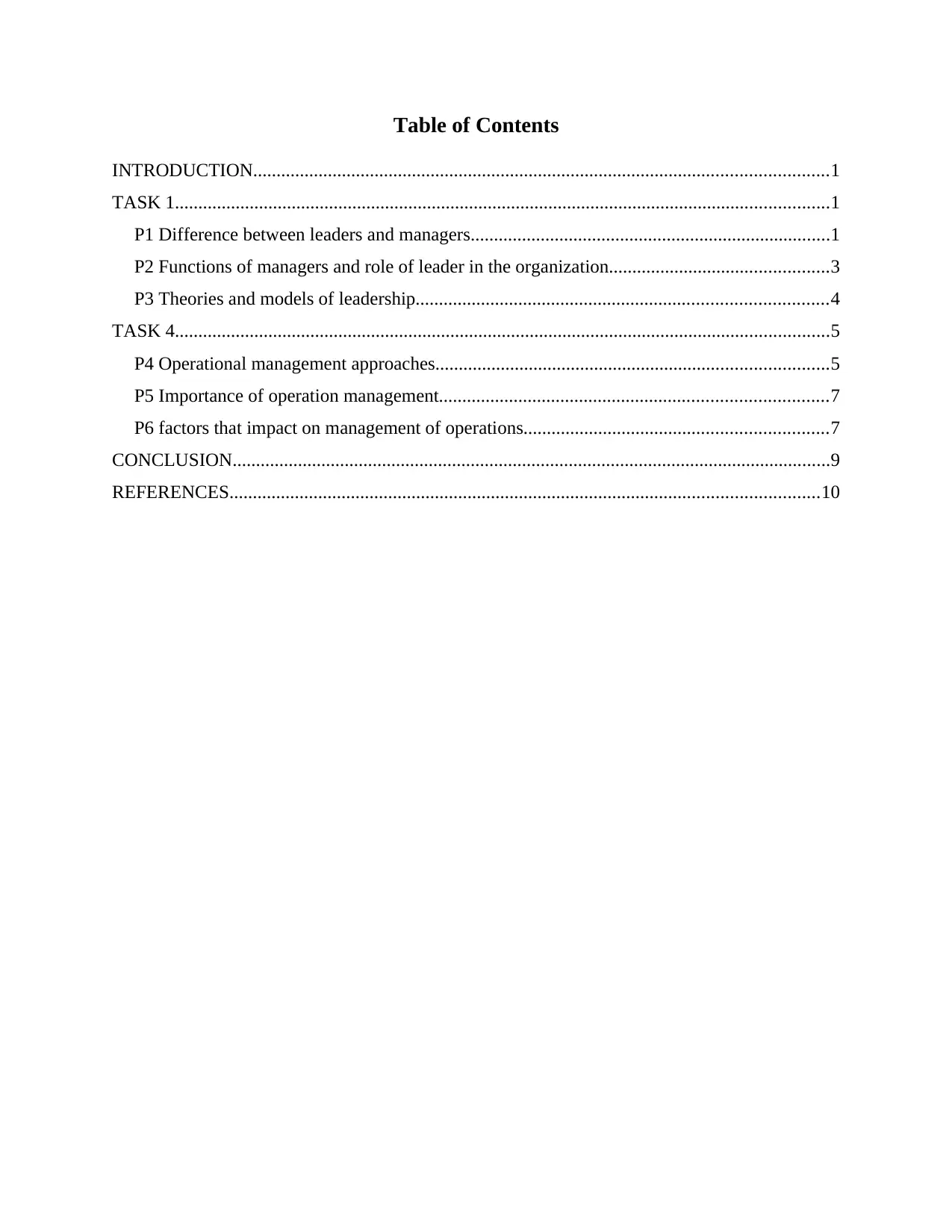
Table of Contents
INTRODUCTION...........................................................................................................................1
TASK 1............................................................................................................................................1
P1 Difference between leaders and managers.............................................................................1
P2 Functions of managers and role of leader in the organization...............................................3
P3 Theories and models of leadership........................................................................................4
TASK 4............................................................................................................................................5
P4 Operational management approaches....................................................................................5
P5 Importance of operation management...................................................................................7
P6 factors that impact on management of operations.................................................................7
CONCLUSION................................................................................................................................9
REFERENCES..............................................................................................................................10
INTRODUCTION...........................................................................................................................1
TASK 1............................................................................................................................................1
P1 Difference between leaders and managers.............................................................................1
P2 Functions of managers and role of leader in the organization...............................................3
P3 Theories and models of leadership........................................................................................4
TASK 4............................................................................................................................................5
P4 Operational management approaches....................................................................................5
P5 Importance of operation management...................................................................................7
P6 factors that impact on management of operations.................................................................7
CONCLUSION................................................................................................................................9
REFERENCES..............................................................................................................................10
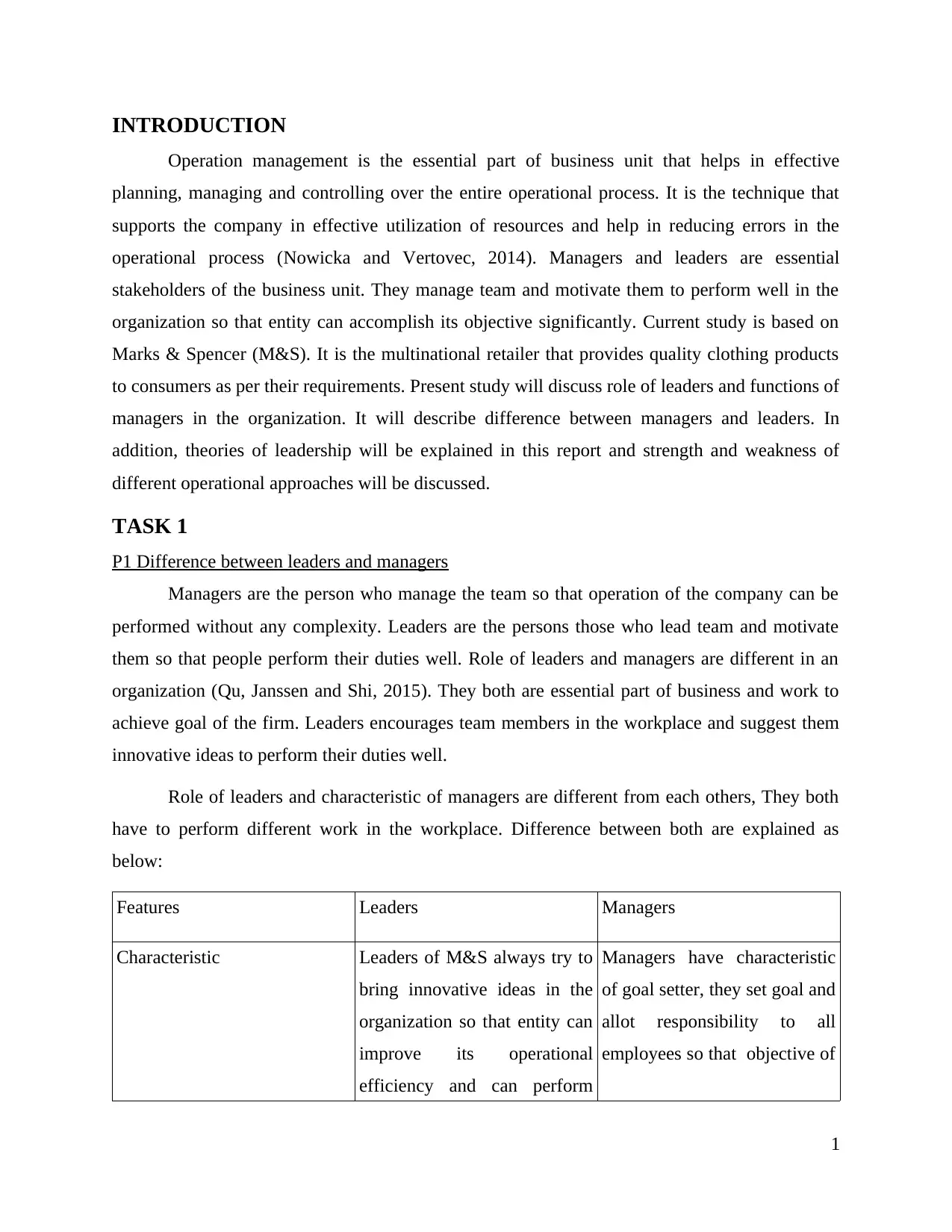
INTRODUCTION
Operation management is the essential part of business unit that helps in effective
planning, managing and controlling over the entire operational process. It is the technique that
supports the company in effective utilization of resources and help in reducing errors in the
operational process (Nowicka and Vertovec, 2014). Managers and leaders are essential
stakeholders of the business unit. They manage team and motivate them to perform well in the
organization so that entity can accomplish its objective significantly. Current study is based on
Marks & Spencer (M&S). It is the multinational retailer that provides quality clothing products
to consumers as per their requirements. Present study will discuss role of leaders and functions of
managers in the organization. It will describe difference between managers and leaders. In
addition, theories of leadership will be explained in this report and strength and weakness of
different operational approaches will be discussed.
TASK 1
P1 Difference between leaders and managers
Managers are the person who manage the team so that operation of the company can be
performed without any complexity. Leaders are the persons those who lead team and motivate
them so that people perform their duties well. Role of leaders and managers are different in an
organization (Qu, Janssen and Shi, 2015). They both are essential part of business and work to
achieve goal of the firm. Leaders encourages team members in the workplace and suggest them
innovative ideas to perform their duties well.
Role of leaders and characteristic of managers are different from each others, They both
have to perform different work in the workplace. Difference between both are explained as
below:
Features Leaders Managers
Characteristic Leaders of M&S always try to
bring innovative ideas in the
organization so that entity can
improve its operational
efficiency and can perform
Managers have characteristic
of goal setter, they set goal and
allot responsibility to all
employees so that objective of
1
Operation management is the essential part of business unit that helps in effective
planning, managing and controlling over the entire operational process. It is the technique that
supports the company in effective utilization of resources and help in reducing errors in the
operational process (Nowicka and Vertovec, 2014). Managers and leaders are essential
stakeholders of the business unit. They manage team and motivate them to perform well in the
organization so that entity can accomplish its objective significantly. Current study is based on
Marks & Spencer (M&S). It is the multinational retailer that provides quality clothing products
to consumers as per their requirements. Present study will discuss role of leaders and functions of
managers in the organization. It will describe difference between managers and leaders. In
addition, theories of leadership will be explained in this report and strength and weakness of
different operational approaches will be discussed.
TASK 1
P1 Difference between leaders and managers
Managers are the person who manage the team so that operation of the company can be
performed without any complexity. Leaders are the persons those who lead team and motivate
them so that people perform their duties well. Role of leaders and managers are different in an
organization (Qu, Janssen and Shi, 2015). They both are essential part of business and work to
achieve goal of the firm. Leaders encourages team members in the workplace and suggest them
innovative ideas to perform their duties well.
Role of leaders and characteristic of managers are different from each others, They both
have to perform different work in the workplace. Difference between both are explained as
below:
Features Leaders Managers
Characteristic Leaders of M&S always try to
bring innovative ideas in the
organization so that entity can
improve its operational
efficiency and can perform
Managers have characteristic
of goal setter, they set goal and
allot responsibility to all
employees so that objective of
1
⊘ This is a preview!⊘
Do you want full access?
Subscribe today to unlock all pages.

Trusted by 1+ million students worldwide
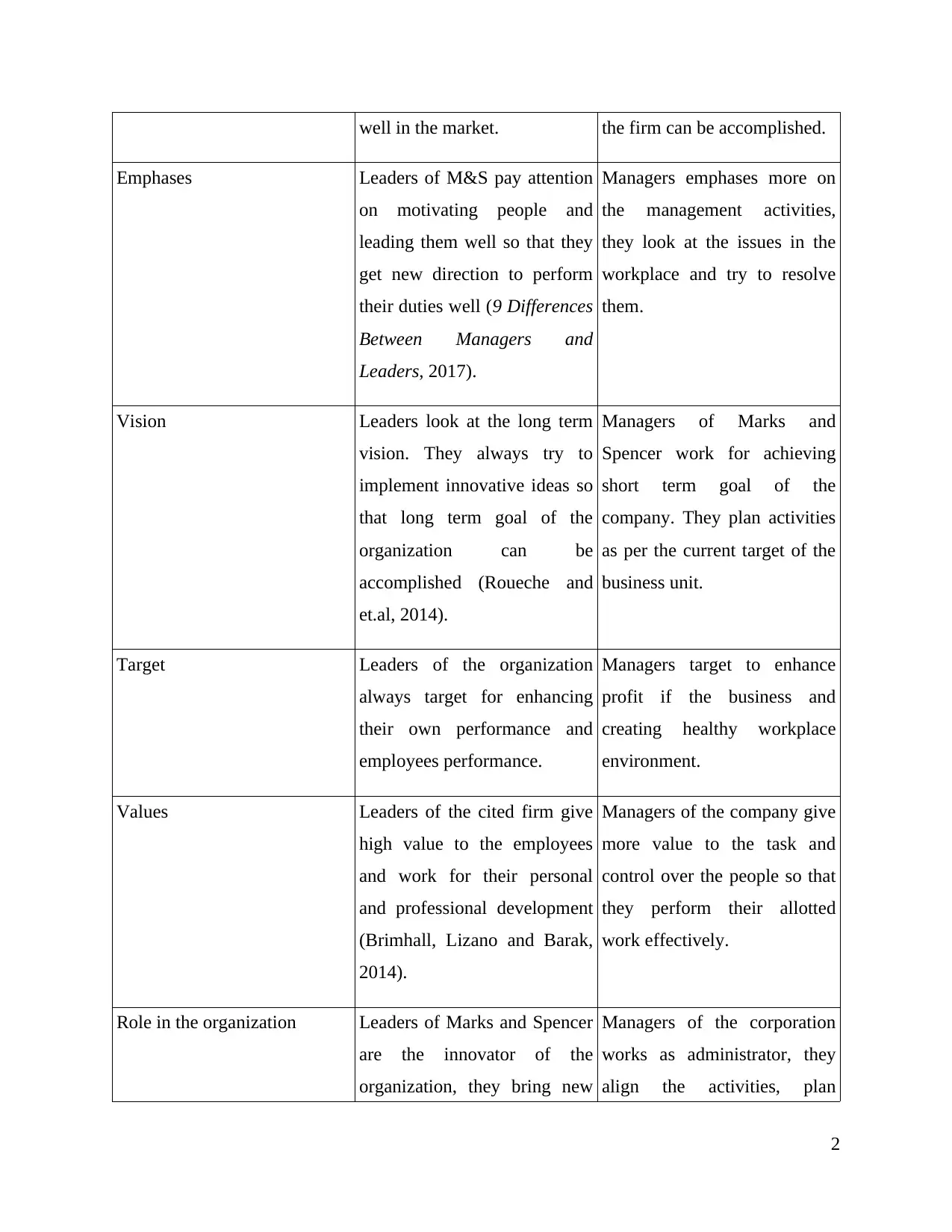
well in the market. the firm can be accomplished.
Emphases Leaders of M&S pay attention
on motivating people and
leading them well so that they
get new direction to perform
their duties well (9 Differences
Between Managers and
Leaders, 2017).
Managers emphases more on
the management activities,
they look at the issues in the
workplace and try to resolve
them.
Vision Leaders look at the long term
vision. They always try to
implement innovative ideas so
that long term goal of the
organization can be
accomplished (Roueche and
et.al, 2014).
Managers of Marks and
Spencer work for achieving
short term goal of the
company. They plan activities
as per the current target of the
business unit.
Target Leaders of the organization
always target for enhancing
their own performance and
employees performance.
Managers target to enhance
profit if the business and
creating healthy workplace
environment.
Values Leaders of the cited firm give
high value to the employees
and work for their personal
and professional development
(Brimhall, Lizano and Barak,
2014).
Managers of the company give
more value to the task and
control over the people so that
they perform their allotted
work effectively.
Role in the organization Leaders of Marks and Spencer
are the innovator of the
organization, they bring new
Managers of the corporation
works as administrator, they
align the activities, plan
2
Emphases Leaders of M&S pay attention
on motivating people and
leading them well so that they
get new direction to perform
their duties well (9 Differences
Between Managers and
Leaders, 2017).
Managers emphases more on
the management activities,
they look at the issues in the
workplace and try to resolve
them.
Vision Leaders look at the long term
vision. They always try to
implement innovative ideas so
that long term goal of the
organization can be
accomplished (Roueche and
et.al, 2014).
Managers of Marks and
Spencer work for achieving
short term goal of the
company. They plan activities
as per the current target of the
business unit.
Target Leaders of the organization
always target for enhancing
their own performance and
employees performance.
Managers target to enhance
profit if the business and
creating healthy workplace
environment.
Values Leaders of the cited firm give
high value to the employees
and work for their personal
and professional development
(Brimhall, Lizano and Barak,
2014).
Managers of the company give
more value to the task and
control over the people so that
they perform their allotted
work effectively.
Role in the organization Leaders of Marks and Spencer
are the innovator of the
organization, they bring new
Managers of the corporation
works as administrator, they
align the activities, plan
2
Paraphrase This Document
Need a fresh take? Get an instant paraphrase of this document with our AI Paraphraser
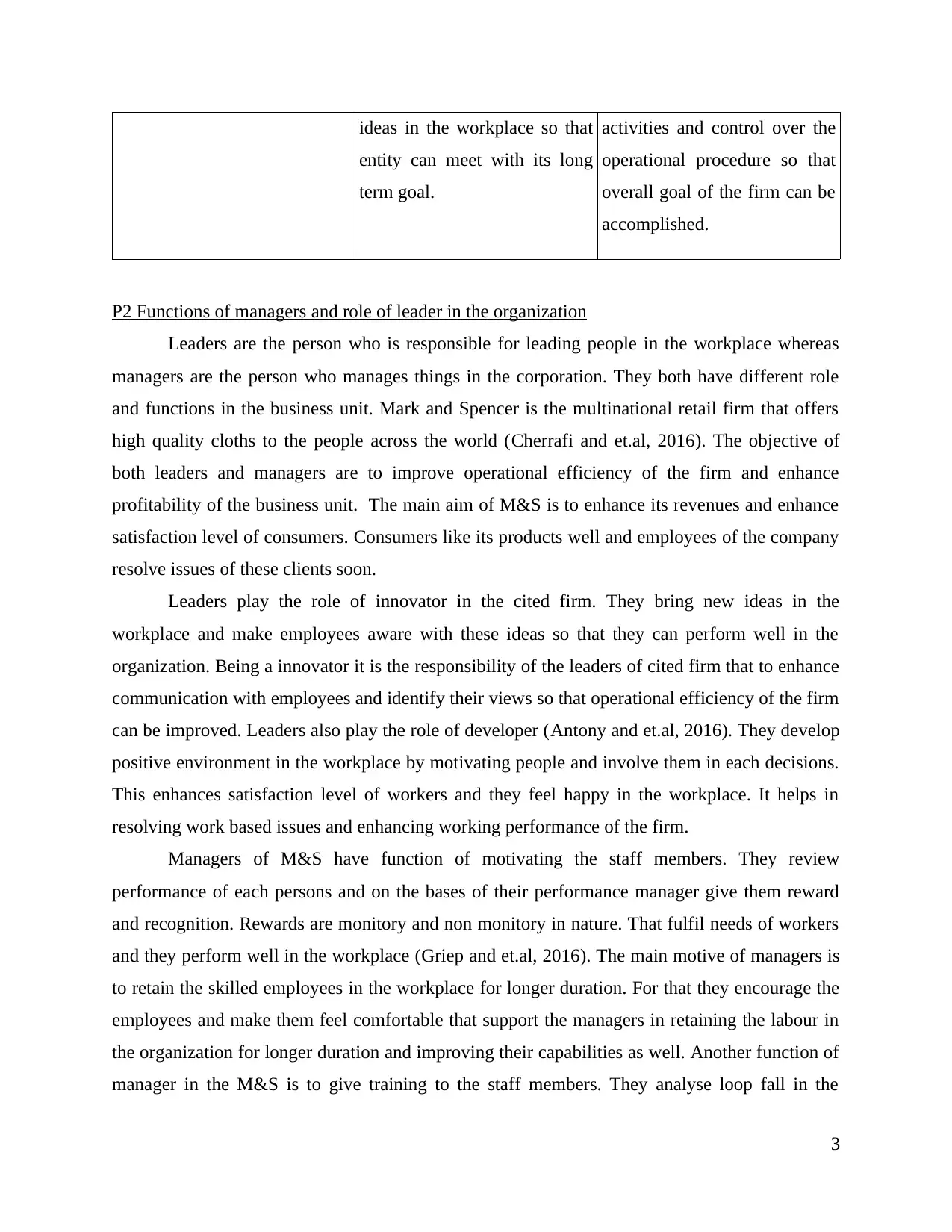
ideas in the workplace so that
entity can meet with its long
term goal.
activities and control over the
operational procedure so that
overall goal of the firm can be
accomplished.
P2 Functions of managers and role of leader in the organization
Leaders are the person who is responsible for leading people in the workplace whereas
managers are the person who manages things in the corporation. They both have different role
and functions in the business unit. Mark and Spencer is the multinational retail firm that offers
high quality cloths to the people across the world (Cherrafi and et.al, 2016). The objective of
both leaders and managers are to improve operational efficiency of the firm and enhance
profitability of the business unit. The main aim of M&S is to enhance its revenues and enhance
satisfaction level of consumers. Consumers like its products well and employees of the company
resolve issues of these clients soon.
Leaders play the role of innovator in the cited firm. They bring new ideas in the
workplace and make employees aware with these ideas so that they can perform well in the
organization. Being a innovator it is the responsibility of the leaders of cited firm that to enhance
communication with employees and identify their views so that operational efficiency of the firm
can be improved. Leaders also play the role of developer (Antony and et.al, 2016). They develop
positive environment in the workplace by motivating people and involve them in each decisions.
This enhances satisfaction level of workers and they feel happy in the workplace. It helps in
resolving work based issues and enhancing working performance of the firm.
Managers of M&S have function of motivating the staff members. They review
performance of each persons and on the bases of their performance manager give them reward
and recognition. Rewards are monitory and non monitory in nature. That fulfil needs of workers
and they perform well in the workplace (Griep and et.al, 2016). The main motive of managers is
to retain the skilled employees in the workplace for longer duration. For that they encourage the
employees and make them feel comfortable that support the managers in retaining the labour in
the organization for longer duration and improving their capabilities as well. Another function of
manager in the M&S is to give training to the staff members. They analyse loop fall in the
3
entity can meet with its long
term goal.
activities and control over the
operational procedure so that
overall goal of the firm can be
accomplished.
P2 Functions of managers and role of leader in the organization
Leaders are the person who is responsible for leading people in the workplace whereas
managers are the person who manages things in the corporation. They both have different role
and functions in the business unit. Mark and Spencer is the multinational retail firm that offers
high quality cloths to the people across the world (Cherrafi and et.al, 2016). The objective of
both leaders and managers are to improve operational efficiency of the firm and enhance
profitability of the business unit. The main aim of M&S is to enhance its revenues and enhance
satisfaction level of consumers. Consumers like its products well and employees of the company
resolve issues of these clients soon.
Leaders play the role of innovator in the cited firm. They bring new ideas in the
workplace and make employees aware with these ideas so that they can perform well in the
organization. Being a innovator it is the responsibility of the leaders of cited firm that to enhance
communication with employees and identify their views so that operational efficiency of the firm
can be improved. Leaders also play the role of developer (Antony and et.al, 2016). They develop
positive environment in the workplace by motivating people and involve them in each decisions.
This enhances satisfaction level of workers and they feel happy in the workplace. It helps in
resolving work based issues and enhancing working performance of the firm.
Managers of M&S have function of motivating the staff members. They review
performance of each persons and on the bases of their performance manager give them reward
and recognition. Rewards are monitory and non monitory in nature. That fulfil needs of workers
and they perform well in the workplace (Griep and et.al, 2016). The main motive of managers is
to retain the skilled employees in the workplace for longer duration. For that they encourage the
employees and make them feel comfortable that support the managers in retaining the labour in
the organization for longer duration and improving their capabilities as well. Another function of
manager in the M&S is to give training to the staff members. They analyse loop fall in the
3
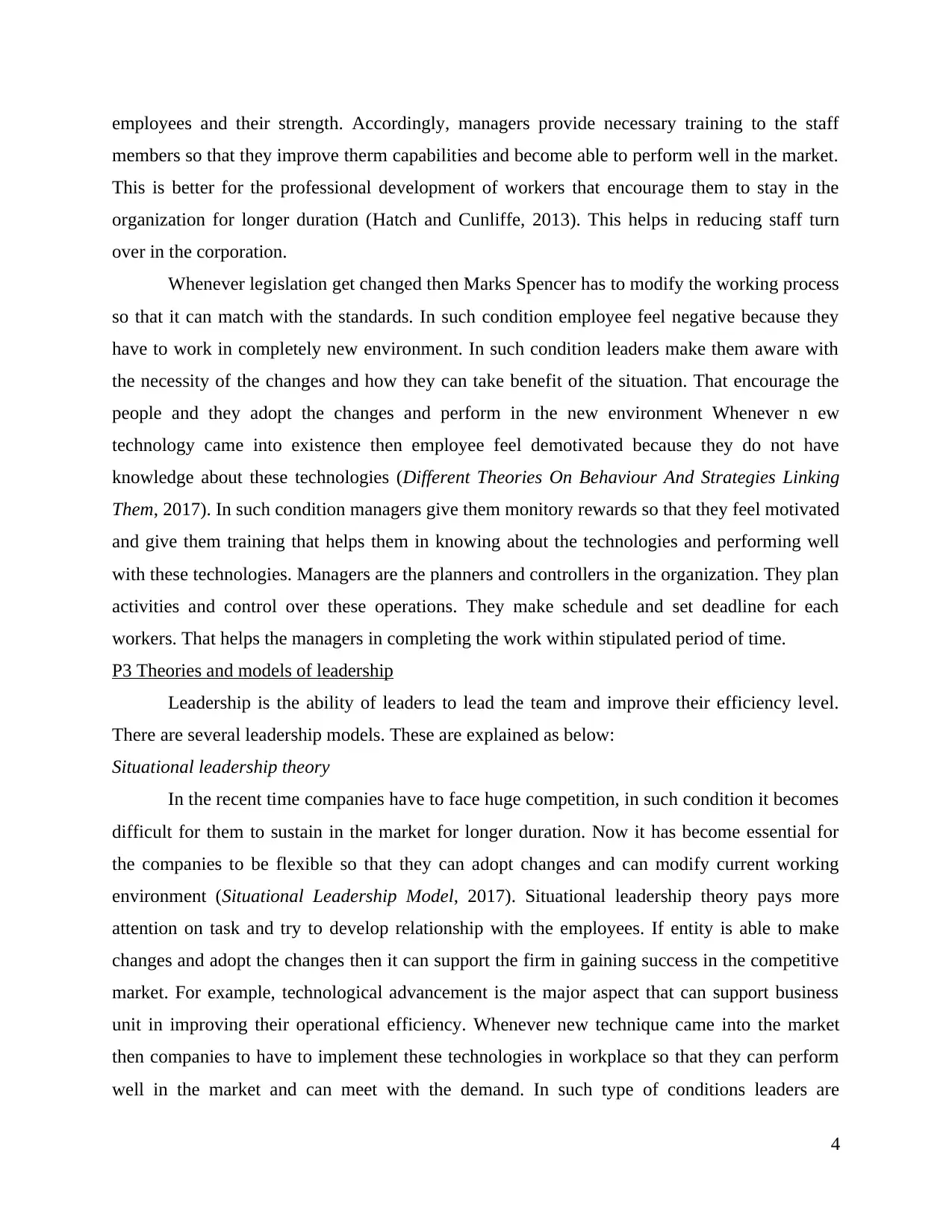
employees and their strength. Accordingly, managers provide necessary training to the staff
members so that they improve therm capabilities and become able to perform well in the market.
This is better for the professional development of workers that encourage them to stay in the
organization for longer duration (Hatch and Cunliffe, 2013). This helps in reducing staff turn
over in the corporation.
Whenever legislation get changed then Marks Spencer has to modify the working process
so that it can match with the standards. In such condition employee feel negative because they
have to work in completely new environment. In such condition leaders make them aware with
the necessity of the changes and how they can take benefit of the situation. That encourage the
people and they adopt the changes and perform in the new environment Whenever n ew
technology came into existence then employee feel demotivated because they do not have
knowledge about these technologies (Different Theories On Behaviour And Strategies Linking
Them, 2017). In such condition managers give them monitory rewards so that they feel motivated
and give them training that helps them in knowing about the technologies and performing well
with these technologies. Managers are the planners and controllers in the organization. They plan
activities and control over these operations. They make schedule and set deadline for each
workers. That helps the managers in completing the work within stipulated period of time.
P3 Theories and models of leadership
Leadership is the ability of leaders to lead the team and improve their efficiency level.
There are several leadership models. These are explained as below:
Situational leadership theory
In the recent time companies have to face huge competition, in such condition it becomes
difficult for them to sustain in the market for longer duration. Now it has become essential for
the companies to be flexible so that they can adopt changes and can modify current working
environment (Situational Leadership Model, 2017). Situational leadership theory pays more
attention on task and try to develop relationship with the employees. If entity is able to make
changes and adopt the changes then it can support the firm in gaining success in the competitive
market. For example, technological advancement is the major aspect that can support business
unit in improving their operational efficiency. Whenever new technique came into the market
then companies to have to implement these technologies in workplace so that they can perform
well in the market and can meet with the demand. In such type of conditions leaders are
4
members so that they improve therm capabilities and become able to perform well in the market.
This is better for the professional development of workers that encourage them to stay in the
organization for longer duration (Hatch and Cunliffe, 2013). This helps in reducing staff turn
over in the corporation.
Whenever legislation get changed then Marks Spencer has to modify the working process
so that it can match with the standards. In such condition employee feel negative because they
have to work in completely new environment. In such condition leaders make them aware with
the necessity of the changes and how they can take benefit of the situation. That encourage the
people and they adopt the changes and perform in the new environment Whenever n ew
technology came into existence then employee feel demotivated because they do not have
knowledge about these technologies (Different Theories On Behaviour And Strategies Linking
Them, 2017). In such condition managers give them monitory rewards so that they feel motivated
and give them training that helps them in knowing about the technologies and performing well
with these technologies. Managers are the planners and controllers in the organization. They plan
activities and control over these operations. They make schedule and set deadline for each
workers. That helps the managers in completing the work within stipulated period of time.
P3 Theories and models of leadership
Leadership is the ability of leaders to lead the team and improve their efficiency level.
There are several leadership models. These are explained as below:
Situational leadership theory
In the recent time companies have to face huge competition, in such condition it becomes
difficult for them to sustain in the market for longer duration. Now it has become essential for
the companies to be flexible so that they can adopt changes and can modify current working
environment (Situational Leadership Model, 2017). Situational leadership theory pays more
attention on task and try to develop relationship with the employees. If entity is able to make
changes and adopt the changes then it can support the firm in gaining success in the competitive
market. For example, technological advancement is the major aspect that can support business
unit in improving their operational efficiency. Whenever new technique came into the market
then companies to have to implement these technologies in workplace so that they can perform
well in the market and can meet with the demand. In such type of conditions leaders are
4
⊘ This is a preview!⊘
Do you want full access?
Subscribe today to unlock all pages.

Trusted by 1+ million students worldwide
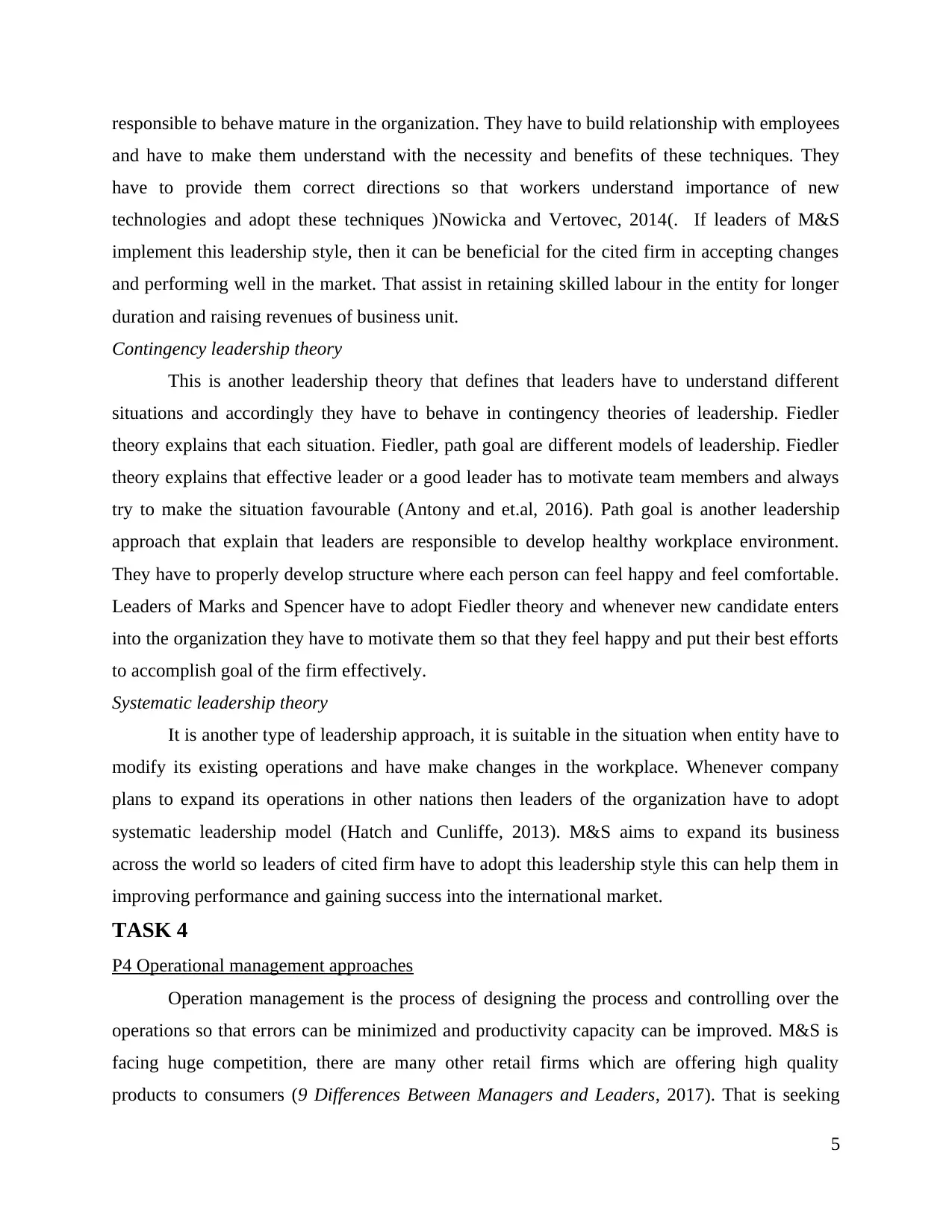
responsible to behave mature in the organization. They have to build relationship with employees
and have to make them understand with the necessity and benefits of these techniques. They
have to provide them correct directions so that workers understand importance of new
technologies and adopt these techniques )Nowicka and Vertovec, 2014(. If leaders of M&S
implement this leadership style, then it can be beneficial for the cited firm in accepting changes
and performing well in the market. That assist in retaining skilled labour in the entity for longer
duration and raising revenues of business unit.
Contingency leadership theory
This is another leadership theory that defines that leaders have to understand different
situations and accordingly they have to behave in contingency theories of leadership. Fiedler
theory explains that each situation. Fiedler, path goal are different models of leadership. Fiedler
theory explains that effective leader or a good leader has to motivate team members and always
try to make the situation favourable (Antony and et.al, 2016). Path goal is another leadership
approach that explain that leaders are responsible to develop healthy workplace environment.
They have to properly develop structure where each person can feel happy and feel comfortable.
Leaders of Marks and Spencer have to adopt Fiedler theory and whenever new candidate enters
into the organization they have to motivate them so that they feel happy and put their best efforts
to accomplish goal of the firm effectively.
Systematic leadership theory
It is another type of leadership approach, it is suitable in the situation when entity have to
modify its existing operations and have make changes in the workplace. Whenever company
plans to expand its operations in other nations then leaders of the organization have to adopt
systematic leadership model (Hatch and Cunliffe, 2013). M&S aims to expand its business
across the world so leaders of cited firm have to adopt this leadership style this can help them in
improving performance and gaining success into the international market.
TASK 4
P4 Operational management approaches
Operation management is the process of designing the process and controlling over the
operations so that errors can be minimized and productivity capacity can be improved. M&S is
facing huge competition, there are many other retail firms which are offering high quality
products to consumers (9 Differences Between Managers and Leaders, 2017). That is seeking
5
and have to make them understand with the necessity and benefits of these techniques. They
have to provide them correct directions so that workers understand importance of new
technologies and adopt these techniques )Nowicka and Vertovec, 2014(. If leaders of M&S
implement this leadership style, then it can be beneficial for the cited firm in accepting changes
and performing well in the market. That assist in retaining skilled labour in the entity for longer
duration and raising revenues of business unit.
Contingency leadership theory
This is another leadership theory that defines that leaders have to understand different
situations and accordingly they have to behave in contingency theories of leadership. Fiedler
theory explains that each situation. Fiedler, path goal are different models of leadership. Fiedler
theory explains that effective leader or a good leader has to motivate team members and always
try to make the situation favourable (Antony and et.al, 2016). Path goal is another leadership
approach that explain that leaders are responsible to develop healthy workplace environment.
They have to properly develop structure where each person can feel happy and feel comfortable.
Leaders of Marks and Spencer have to adopt Fiedler theory and whenever new candidate enters
into the organization they have to motivate them so that they feel happy and put their best efforts
to accomplish goal of the firm effectively.
Systematic leadership theory
It is another type of leadership approach, it is suitable in the situation when entity have to
modify its existing operations and have make changes in the workplace. Whenever company
plans to expand its operations in other nations then leaders of the organization have to adopt
systematic leadership model (Hatch and Cunliffe, 2013). M&S aims to expand its business
across the world so leaders of cited firm have to adopt this leadership style this can help them in
improving performance and gaining success into the international market.
TASK 4
P4 Operational management approaches
Operation management is the process of designing the process and controlling over the
operations so that errors can be minimized and productivity capacity can be improved. M&S is
facing huge competition, there are many other retail firms which are offering high quality
products to consumers (9 Differences Between Managers and Leaders, 2017). That is seeking
5
Paraphrase This Document
Need a fresh take? Get an instant paraphrase of this document with our AI Paraphraser
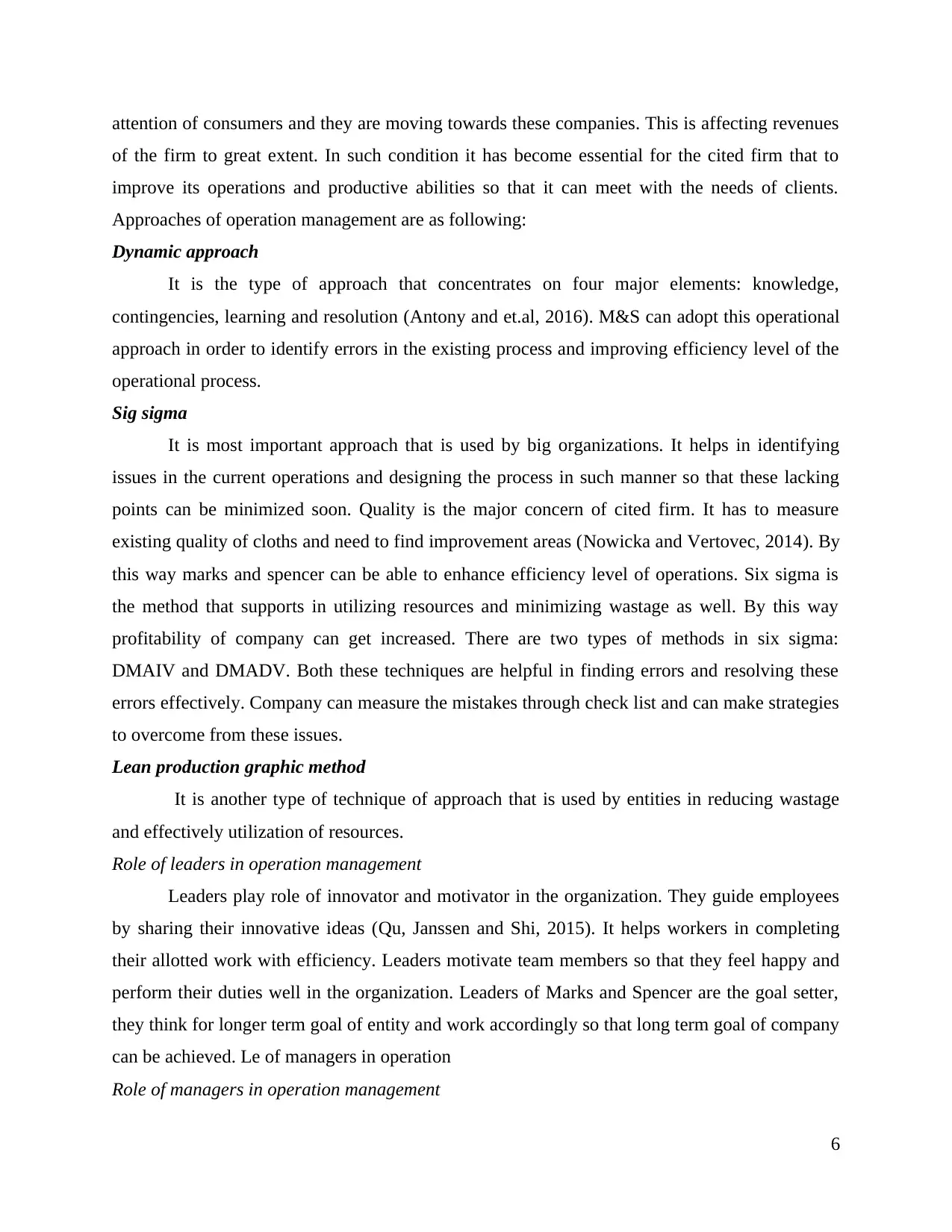
attention of consumers and they are moving towards these companies. This is affecting revenues
of the firm to great extent. In such condition it has become essential for the cited firm that to
improve its operations and productive abilities so that it can meet with the needs of clients.
Approaches of operation management are as following:
Dynamic approach
It is the type of approach that concentrates on four major elements: knowledge,
contingencies, learning and resolution (Antony and et.al, 2016). M&S can adopt this operational
approach in order to identify errors in the existing process and improving efficiency level of the
operational process.
Sig sigma
It is most important approach that is used by big organizations. It helps in identifying
issues in the current operations and designing the process in such manner so that these lacking
points can be minimized soon. Quality is the major concern of cited firm. It has to measure
existing quality of cloths and need to find improvement areas (Nowicka and Vertovec, 2014). By
this way marks and spencer can be able to enhance efficiency level of operations. Six sigma is
the method that supports in utilizing resources and minimizing wastage as well. By this way
profitability of company can get increased. There are two types of methods in six sigma:
DMAIV and DMADV. Both these techniques are helpful in finding errors and resolving these
errors effectively. Company can measure the mistakes through check list and can make strategies
to overcome from these issues.
Lean production graphic method
It is another type of technique of approach that is used by entities in reducing wastage
and effectively utilization of resources.
Role of leaders in operation management
Leaders play role of innovator and motivator in the organization. They guide employees
by sharing their innovative ideas (Qu, Janssen and Shi, 2015). It helps workers in completing
their allotted work with efficiency. Leaders motivate team members so that they feel happy and
perform their duties well in the organization. Leaders of Marks and Spencer are the goal setter,
they think for longer term goal of entity and work accordingly so that long term goal of company
can be achieved. Le of managers in operation
Role of managers in operation management
6
of the firm to great extent. In such condition it has become essential for the cited firm that to
improve its operations and productive abilities so that it can meet with the needs of clients.
Approaches of operation management are as following:
Dynamic approach
It is the type of approach that concentrates on four major elements: knowledge,
contingencies, learning and resolution (Antony and et.al, 2016). M&S can adopt this operational
approach in order to identify errors in the existing process and improving efficiency level of the
operational process.
Sig sigma
It is most important approach that is used by big organizations. It helps in identifying
issues in the current operations and designing the process in such manner so that these lacking
points can be minimized soon. Quality is the major concern of cited firm. It has to measure
existing quality of cloths and need to find improvement areas (Nowicka and Vertovec, 2014). By
this way marks and spencer can be able to enhance efficiency level of operations. Six sigma is
the method that supports in utilizing resources and minimizing wastage as well. By this way
profitability of company can get increased. There are two types of methods in six sigma:
DMAIV and DMADV. Both these techniques are helpful in finding errors and resolving these
errors effectively. Company can measure the mistakes through check list and can make strategies
to overcome from these issues.
Lean production graphic method
It is another type of technique of approach that is used by entities in reducing wastage
and effectively utilization of resources.
Role of leaders in operation management
Leaders play role of innovator and motivator in the organization. They guide employees
by sharing their innovative ideas (Qu, Janssen and Shi, 2015). It helps workers in completing
their allotted work with efficiency. Leaders motivate team members so that they feel happy and
perform their duties well in the organization. Leaders of Marks and Spencer are the goal setter,
they think for longer term goal of entity and work accordingly so that long term goal of company
can be achieved. Le of managers in operation
Role of managers in operation management
6
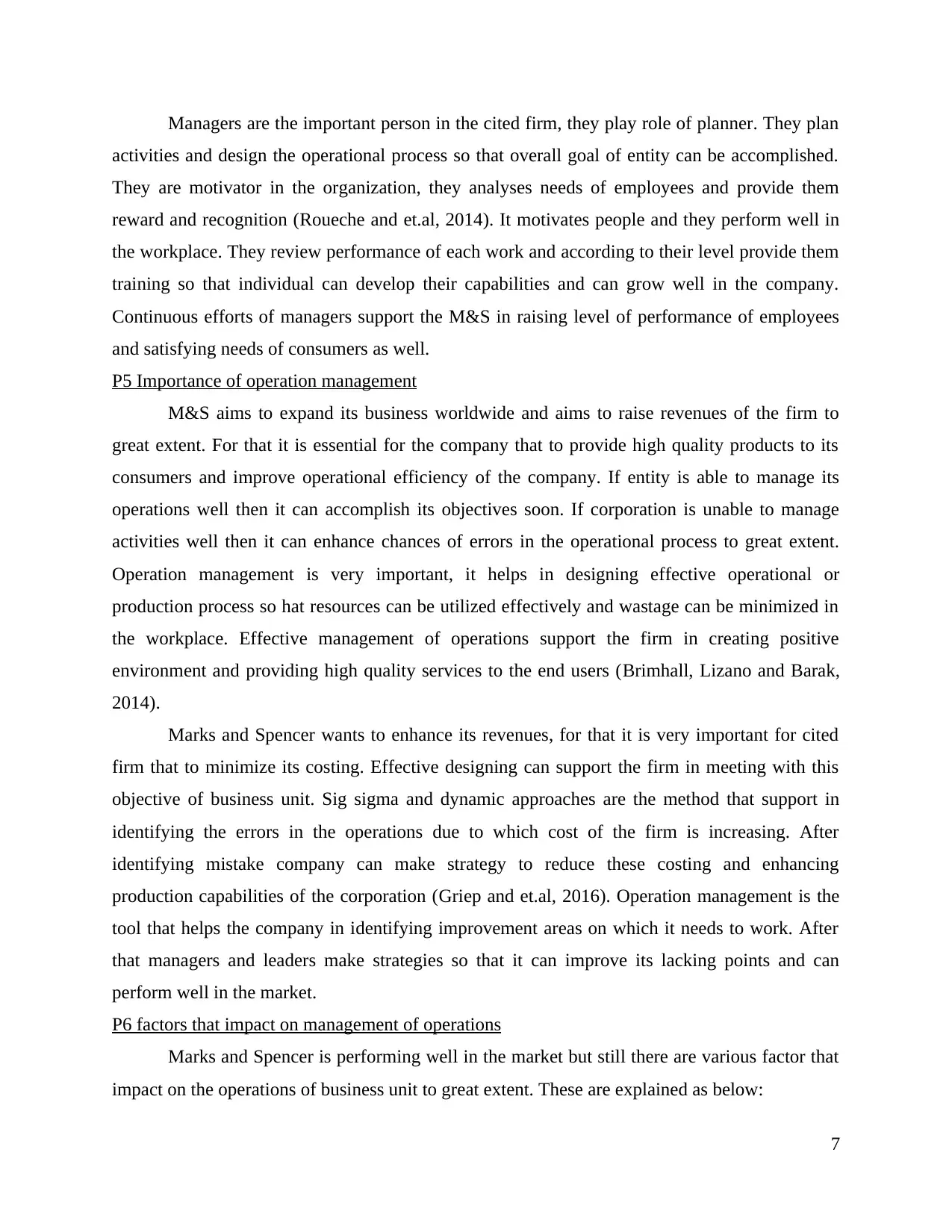
Managers are the important person in the cited firm, they play role of planner. They plan
activities and design the operational process so that overall goal of entity can be accomplished.
They are motivator in the organization, they analyses needs of employees and provide them
reward and recognition (Roueche and et.al, 2014). It motivates people and they perform well in
the workplace. They review performance of each work and according to their level provide them
training so that individual can develop their capabilities and can grow well in the company.
Continuous efforts of managers support the M&S in raising level of performance of employees
and satisfying needs of consumers as well.
P5 Importance of operation management
M&S aims to expand its business worldwide and aims to raise revenues of the firm to
great extent. For that it is essential for the company that to provide high quality products to its
consumers and improve operational efficiency of the company. If entity is able to manage its
operations well then it can accomplish its objectives soon. If corporation is unable to manage
activities well then it can enhance chances of errors in the operational process to great extent.
Operation management is very important, it helps in designing effective operational or
production process so hat resources can be utilized effectively and wastage can be minimized in
the workplace. Effective management of operations support the firm in creating positive
environment and providing high quality services to the end users (Brimhall, Lizano and Barak,
2014).
Marks and Spencer wants to enhance its revenues, for that it is very important for cited
firm that to minimize its costing. Effective designing can support the firm in meeting with this
objective of business unit. Sig sigma and dynamic approaches are the method that support in
identifying the errors in the operations due to which cost of the firm is increasing. After
identifying mistake company can make strategy to reduce these costing and enhancing
production capabilities of the corporation (Griep and et.al, 2016). Operation management is the
tool that helps the company in identifying improvement areas on which it needs to work. After
that managers and leaders make strategies so that it can improve its lacking points and can
perform well in the market.
P6 factors that impact on management of operations
Marks and Spencer is performing well in the market but still there are various factor that
impact on the operations of business unit to great extent. These are explained as below:
7
activities and design the operational process so that overall goal of entity can be accomplished.
They are motivator in the organization, they analyses needs of employees and provide them
reward and recognition (Roueche and et.al, 2014). It motivates people and they perform well in
the workplace. They review performance of each work and according to their level provide them
training so that individual can develop their capabilities and can grow well in the company.
Continuous efforts of managers support the M&S in raising level of performance of employees
and satisfying needs of consumers as well.
P5 Importance of operation management
M&S aims to expand its business worldwide and aims to raise revenues of the firm to
great extent. For that it is essential for the company that to provide high quality products to its
consumers and improve operational efficiency of the company. If entity is able to manage its
operations well then it can accomplish its objectives soon. If corporation is unable to manage
activities well then it can enhance chances of errors in the operational process to great extent.
Operation management is very important, it helps in designing effective operational or
production process so hat resources can be utilized effectively and wastage can be minimized in
the workplace. Effective management of operations support the firm in creating positive
environment and providing high quality services to the end users (Brimhall, Lizano and Barak,
2014).
Marks and Spencer wants to enhance its revenues, for that it is very important for cited
firm that to minimize its costing. Effective designing can support the firm in meeting with this
objective of business unit. Sig sigma and dynamic approaches are the method that support in
identifying the errors in the operations due to which cost of the firm is increasing. After
identifying mistake company can make strategy to reduce these costing and enhancing
production capabilities of the corporation (Griep and et.al, 2016). Operation management is the
tool that helps the company in identifying improvement areas on which it needs to work. After
that managers and leaders make strategies so that it can improve its lacking points and can
perform well in the market.
P6 factors that impact on management of operations
Marks and Spencer is performing well in the market but still there are various factor that
impact on the operations of business unit to great extent. These are explained as below:
7
⊘ This is a preview!⊘
Do you want full access?
Subscribe today to unlock all pages.

Trusted by 1+ million students worldwide
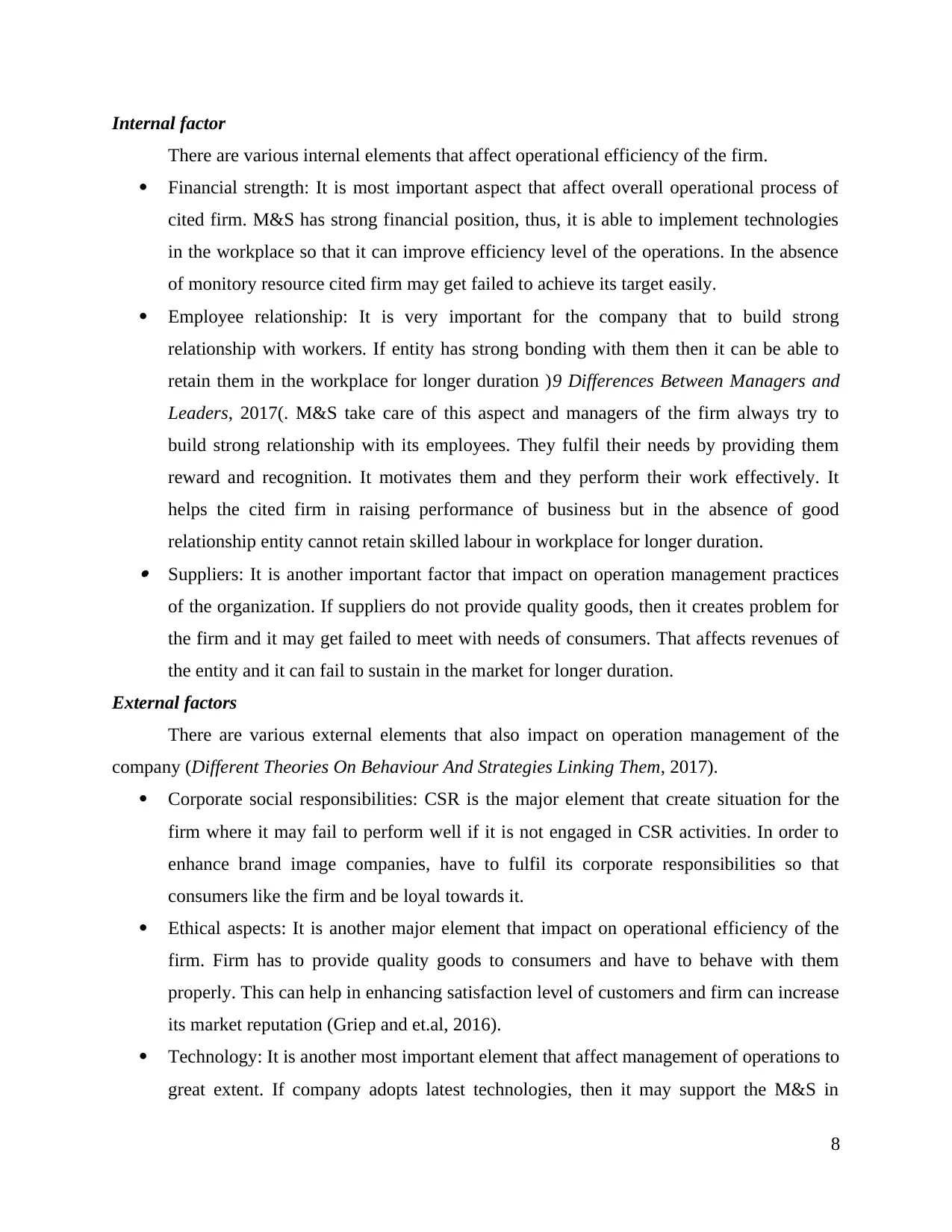
Internal factor
There are various internal elements that affect operational efficiency of the firm.
Financial strength: It is most important aspect that affect overall operational process of
cited firm. M&S has strong financial position, thus, it is able to implement technologies
in the workplace so that it can improve efficiency level of the operations. In the absence
of monitory resource cited firm may get failed to achieve its target easily.
Employee relationship: It is very important for the company that to build strong
relationship with workers. If entity has strong bonding with them then it can be able to
retain them in the workplace for longer duration )9 Differences Between Managers and
Leaders, 2017(. M&S take care of this aspect and managers of the firm always try to
build strong relationship with its employees. They fulfil their needs by providing them
reward and recognition. It motivates them and they perform their work effectively. It
helps the cited firm in raising performance of business but in the absence of good
relationship entity cannot retain skilled labour in workplace for longer duration. Suppliers: It is another important factor that impact on operation management practices
of the organization. If suppliers do not provide quality goods, then it creates problem for
the firm and it may get failed to meet with needs of consumers. That affects revenues of
the entity and it can fail to sustain in the market for longer duration.
External factors
There are various external elements that also impact on operation management of the
company (Different Theories On Behaviour And Strategies Linking Them, 2017).
Corporate social responsibilities: CSR is the major element that create situation for the
firm where it may fail to perform well if it is not engaged in CSR activities. In order to
enhance brand image companies, have to fulfil its corporate responsibilities so that
consumers like the firm and be loyal towards it.
Ethical aspects: It is another major element that impact on operational efficiency of the
firm. Firm has to provide quality goods to consumers and have to behave with them
properly. This can help in enhancing satisfaction level of customers and firm can increase
its market reputation (Griep and et.al, 2016).
Technology: It is another most important element that affect management of operations to
great extent. If company adopts latest technologies, then it may support the M&S in
8
There are various internal elements that affect operational efficiency of the firm.
Financial strength: It is most important aspect that affect overall operational process of
cited firm. M&S has strong financial position, thus, it is able to implement technologies
in the workplace so that it can improve efficiency level of the operations. In the absence
of monitory resource cited firm may get failed to achieve its target easily.
Employee relationship: It is very important for the company that to build strong
relationship with workers. If entity has strong bonding with them then it can be able to
retain them in the workplace for longer duration )9 Differences Between Managers and
Leaders, 2017(. M&S take care of this aspect and managers of the firm always try to
build strong relationship with its employees. They fulfil their needs by providing them
reward and recognition. It motivates them and they perform their work effectively. It
helps the cited firm in raising performance of business but in the absence of good
relationship entity cannot retain skilled labour in workplace for longer duration. Suppliers: It is another important factor that impact on operation management practices
of the organization. If suppliers do not provide quality goods, then it creates problem for
the firm and it may get failed to meet with needs of consumers. That affects revenues of
the entity and it can fail to sustain in the market for longer duration.
External factors
There are various external elements that also impact on operation management of the
company (Different Theories On Behaviour And Strategies Linking Them, 2017).
Corporate social responsibilities: CSR is the major element that create situation for the
firm where it may fail to perform well if it is not engaged in CSR activities. In order to
enhance brand image companies, have to fulfil its corporate responsibilities so that
consumers like the firm and be loyal towards it.
Ethical aspects: It is another major element that impact on operational efficiency of the
firm. Firm has to provide quality goods to consumers and have to behave with them
properly. This can help in enhancing satisfaction level of customers and firm can increase
its market reputation (Griep and et.al, 2016).
Technology: It is another most important element that affect management of operations to
great extent. If company adopts latest technologies, then it may support the M&S in
8
Paraphrase This Document
Need a fresh take? Get an instant paraphrase of this document with our AI Paraphraser
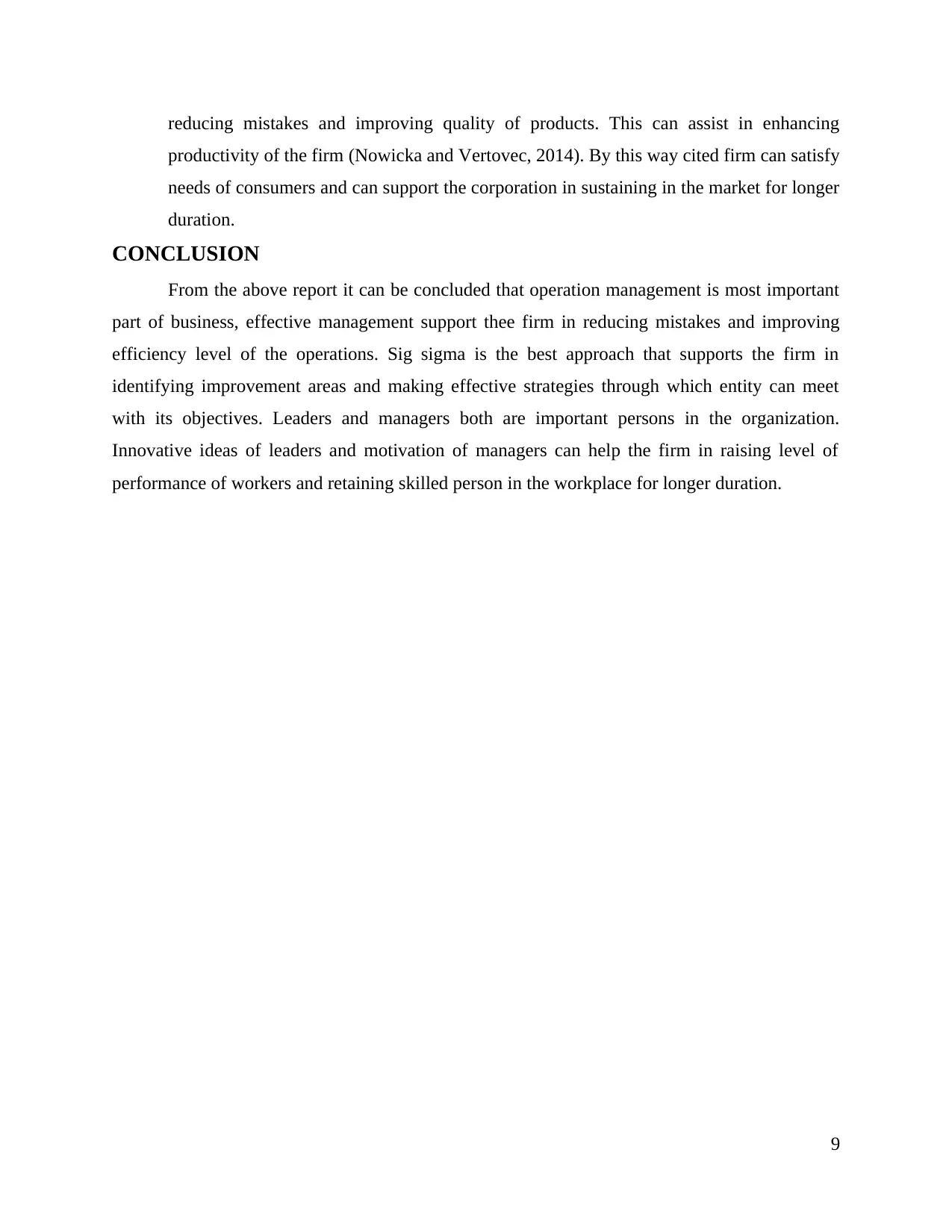
reducing mistakes and improving quality of products. This can assist in enhancing
productivity of the firm (Nowicka and Vertovec, 2014). By this way cited firm can satisfy
needs of consumers and can support the corporation in sustaining in the market for longer
duration.
CONCLUSION
From the above report it can be concluded that operation management is most important
part of business, effective management support thee firm in reducing mistakes and improving
efficiency level of the operations. Sig sigma is the best approach that supports the firm in
identifying improvement areas and making effective strategies through which entity can meet
with its objectives. Leaders and managers both are important persons in the organization.
Innovative ideas of leaders and motivation of managers can help the firm in raising level of
performance of workers and retaining skilled person in the workplace for longer duration.
9
productivity of the firm (Nowicka and Vertovec, 2014). By this way cited firm can satisfy
needs of consumers and can support the corporation in sustaining in the market for longer
duration.
CONCLUSION
From the above report it can be concluded that operation management is most important
part of business, effective management support thee firm in reducing mistakes and improving
efficiency level of the operations. Sig sigma is the best approach that supports the firm in
identifying improvement areas and making effective strategies through which entity can meet
with its objectives. Leaders and managers both are important persons in the organization.
Innovative ideas of leaders and motivation of managers can help the firm in raising level of
performance of workers and retaining skilled person in the workplace for longer duration.
9
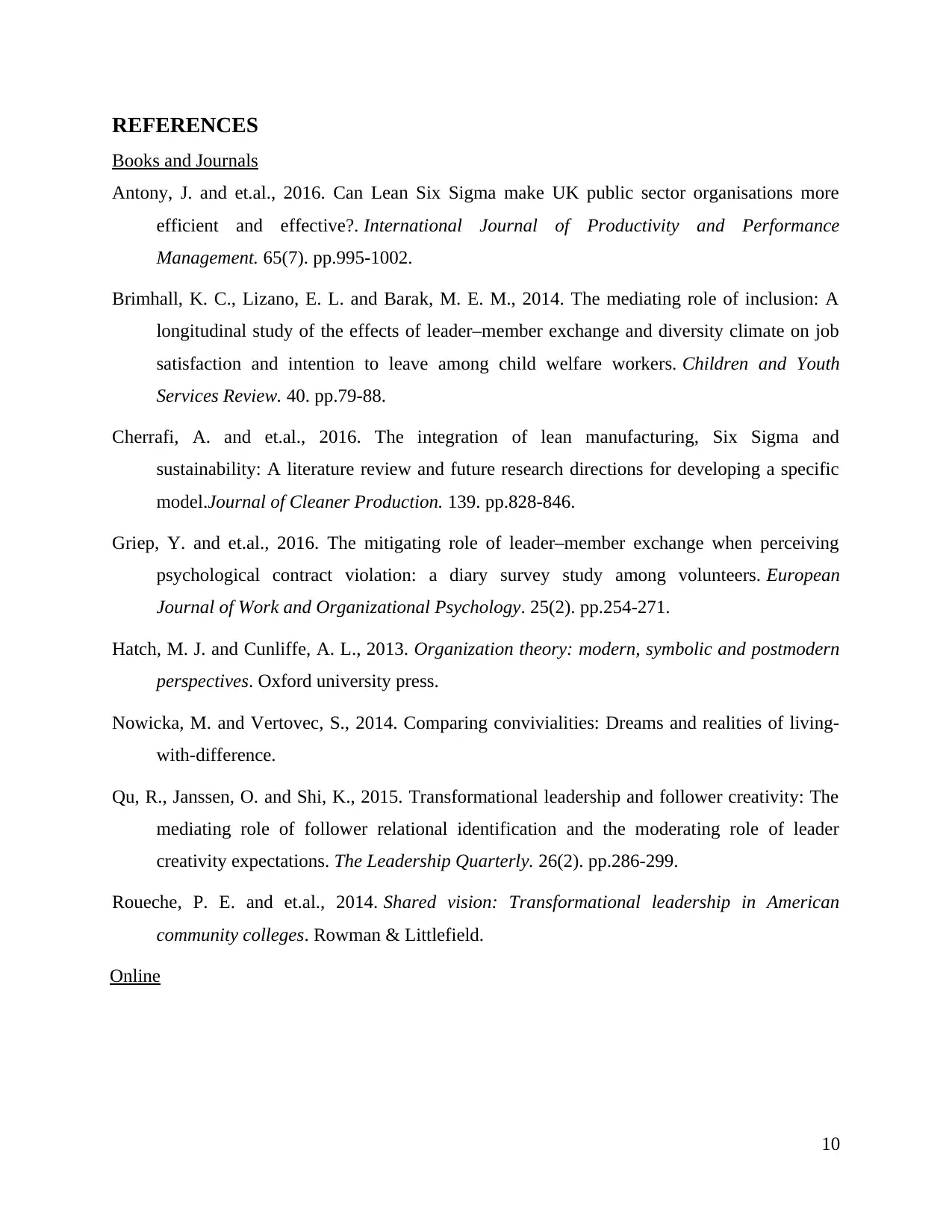
REFERENCES
Books and Journals
Antony, J. and et.al., 2016. Can Lean Six Sigma make UK public sector organisations more
efficient and effective?. International Journal of Productivity and Performance
Management. 65(7). pp.995-1002.
Brimhall, K. C., Lizano, E. L. and Barak, M. E. M., 2014. The mediating role of inclusion: A
longitudinal study of the effects of leader–member exchange and diversity climate on job
satisfaction and intention to leave among child welfare workers. Children and Youth
Services Review. 40. pp.79-88.
Cherrafi, A. and et.al., 2016. The integration of lean manufacturing, Six Sigma and
sustainability: A literature review and future research directions for developing a specific
model.Journal of Cleaner Production. 139. pp.828-846.
Griep, Y. and et.al., 2016. The mitigating role of leader‒member exchange when perceiving
psychological contract violation: a diary survey study among volunteers. European
Journal of Work and Organizational Psychology. 25(2). pp.254-271.
Hatch, M. J. and Cunliffe, A. L., 2013. Organization theory: modern, symbolic and postmodern
perspectives. Oxford university press.
Nowicka, M. and Vertovec, S., 2014. Comparing convivialities: Dreams and realities of living-
with-difference.
Qu, R., Janssen, O. and Shi, K., 2015. Transformational leadership and follower creativity: The
mediating role of follower relational identification and the moderating role of leader
creativity expectations. The Leadership Quarterly. 26(2). pp.286-299.
Roueche, P. E. and et.al., 2014. Shared vision: Transformational leadership in American
community colleges. Rowman & Littlefield.
Online
10
Books and Journals
Antony, J. and et.al., 2016. Can Lean Six Sigma make UK public sector organisations more
efficient and effective?. International Journal of Productivity and Performance
Management. 65(7). pp.995-1002.
Brimhall, K. C., Lizano, E. L. and Barak, M. E. M., 2014. The mediating role of inclusion: A
longitudinal study of the effects of leader–member exchange and diversity climate on job
satisfaction and intention to leave among child welfare workers. Children and Youth
Services Review. 40. pp.79-88.
Cherrafi, A. and et.al., 2016. The integration of lean manufacturing, Six Sigma and
sustainability: A literature review and future research directions for developing a specific
model.Journal of Cleaner Production. 139. pp.828-846.
Griep, Y. and et.al., 2016. The mitigating role of leader‒member exchange when perceiving
psychological contract violation: a diary survey study among volunteers. European
Journal of Work and Organizational Psychology. 25(2). pp.254-271.
Hatch, M. J. and Cunliffe, A. L., 2013. Organization theory: modern, symbolic and postmodern
perspectives. Oxford university press.
Nowicka, M. and Vertovec, S., 2014. Comparing convivialities: Dreams and realities of living-
with-difference.
Qu, R., Janssen, O. and Shi, K., 2015. Transformational leadership and follower creativity: The
mediating role of follower relational identification and the moderating role of leader
creativity expectations. The Leadership Quarterly. 26(2). pp.286-299.
Roueche, P. E. and et.al., 2014. Shared vision: Transformational leadership in American
community colleges. Rowman & Littlefield.
Online
10
⊘ This is a preview!⊘
Do you want full access?
Subscribe today to unlock all pages.

Trusted by 1+ million students worldwide
1 out of 13
Related Documents
Your All-in-One AI-Powered Toolkit for Academic Success.
+13062052269
info@desklib.com
Available 24*7 on WhatsApp / Email
![[object Object]](/_next/static/media/star-bottom.7253800d.svg)
Unlock your academic potential
Copyright © 2020–2025 A2Z Services. All Rights Reserved. Developed and managed by ZUCOL.





